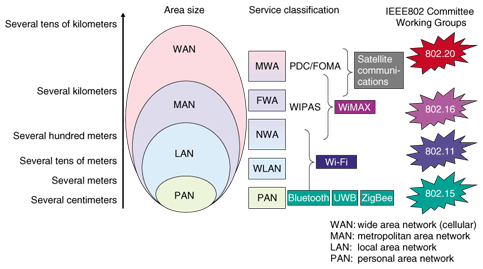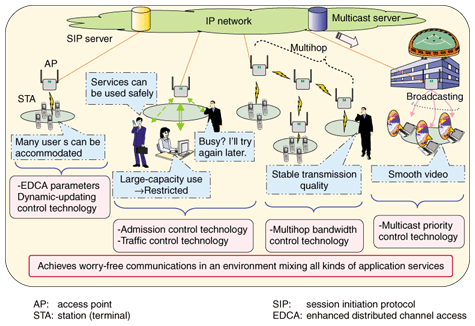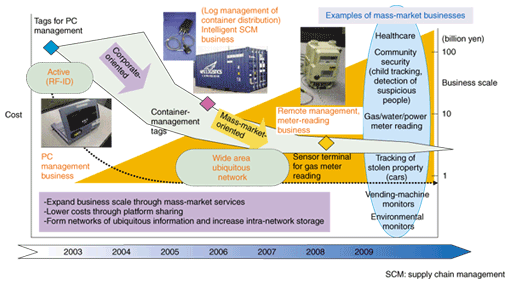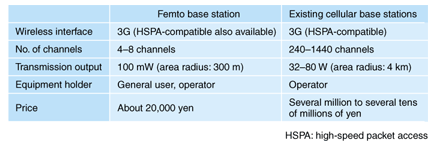 |
|||||||||||||||||||
|
|
|||||||||||||||||||
|
Special Feature: NTT Tsukuba Forum 2007 Workshop Lectures 3 Vol. 6, No. 5, pp. 16–23, May 2008. https://doi.org/10.53829/ntr200805sf3  Trends in Wireless Access System Technology toward Expanded Broadband based on Optical and Wireless SystemsAbstractWireless access systems that support optical access services require further technical development for the full-scale optical era. This article describes trends in wireless technologies and new approaches to wireless systems at NTT toward the Next Generation Network.
1. Overview of wireless systemsThe development of wireless access technology at NTT continues to expand as information-communications methods diversify. Service formats are expanding to meet a wide variety of needs. From early cell phones, they have come to include (i) satellite communications for ships, remote islands, disaster-stricken areas, and other locations where wired access is impossible, (ii) fixed wireless access for rural areas where deployment of optical fibers is difficult, and (iii) wireless local area networks for mobile terminals and places where people gather (public hotspots). It is assumed that wireless access systems will be used together with optical fiber. These systems can be classified according to the length of the wireless interval, as listed below in the order of decreasing distance.
If we were to associate these categories of wireless access with standardization committees, we would see that Wi-Fi corresponds to 802.11 Wireless Local Area Networks, WiMAX to 802.16 WMAN (wireless metropolitan area networks), and Bluetooth, UWB, ZigBee, and similar technologies to 802.15 WPAN (wireless personal area networks). A new category called 802.20 MBWA (mobile broadband wireless access) has also appeared for mobile systems (Fig. 1).
In Fig. 1, the service area increases as we move upward. The upper limit of a PAN is several meters and the upper limits for a WLAN, NWA, and FWA are several tens of meters, 100 meters, and 700 meters, respectively. Transmission speed increases as we move downward in the figure. Although high-speed and wide-area communications would certainly be convenient, the inability to achieve these features simultaneously is a characteristic of wireless systems. It therefore becomes necessary to compartmentalize frequencies and develop technology for two types of systems: one that achieves high speeds but short distances and the other that covers a wide area with relatively low speeds. For this reason, usable frequency bands are being carefully allocated for specific service formats (Fig. 2).
Each frequency band has its advantages and disadvantages. As reflected by the fact that popular mobile systems congregate toward lower frequencies, lower frequencies mean longer wavelengths that travel further. Frequencies of this type, however, cannot provide sufficient bandwidth, which limits their conversion to broadband communications. In contrast, higher frequencies can provide sufficient bandwidth but their shorter wavelengths make for shorter traveling distances. 2. Satellite communications systemsDevelopment planning of satellite communication systems requires a long time span on the assumption that a satellite is launched and services are then offered for about ten years. For this reason, it seems to be difficult for new technology to be quickly incorporated into satellite communication systems. Needless to say, the major role of satellite communication systems is to provide communication services to remote islands, where wired systems cannot be constructed, and to the site of a disaster where wired systems have been cut. But besides this role, we can consider various services that could be offered by satellite communication systems by making the best use of their characteristics such as wide service area and high average traffic fluctuation. Accordingly, we are researching and developing technologies for providing services ranging from low- to high-speed ones from a single satellite communication system. For example, terrestrial terminals can be used on ocean-going ships where land-based stations are unlikely to be installed, and broadband services may be provided on fast-moving airplanes or shinkansen (bullet trains), in addition to 3G (third generation) or Beyond 3G (B3G) services for mobile terminals and so on. One such service is a multipoint data-gathering satellite communication system making use of the wide-area and disaster-resistant properties of satellite communication systems. We are researching and developing this system based on the concept of contributing to a safe and secure regional community and disaster-resistant society. The normal, day-to-day task of this system would be to collect various types of measured and monitored data—including meteorological, environmental, and oceanic data—from various points distributed throughout the country in every area including the sea. Then, when a disaster occurred, the system would immediately switch to activities that aim to prevent the stricken area from becoming isolated. This concept allows the frequency bandwidth allocated as part of the communication infrastructure for times of disasters and emergencies to be used effectively during normal times. Furthermore, with respect to the satellite itself, we are developing an ultralight large antenna reflector. Larger satellites can support smaller terminals, so this offers advantages on the terrestrial side. However, there are limits on the weight of the satellite and its storage size at launch, so simply increasing the storage size at launch is not a viable option. The Engineering Test Satellite VIII (ETS-VIII) currently in operation features a large antenna with an aperture diameter of about 12 m. In contrast, the new antenna under development will be in the 20-m class. This required a new structure based on an entirely new concept (tendon-reinforced structure) to allow for buckling distortion in the support structure. This new structure can reduce the reflector's weight per unit area to one-fourth that of the ETS-VIII. The needs of satellite communications are many and varied. From the viewpoint of usage technology, achieving safety and security and providing a universal information-communications environment are particularly important. From the viewpoint of providing a transmission path, there is a need, of course, for increasing bandwidth and improving mobility, but also for supporting ultralow speeds and wide-area service and enhancing security including measures against eavesdropping. 3. FWA systemsNTT's wireless IP access system (WIPAS), an FWA system, is a broadband access system using quasi-millimeter waves in the 26-GHz frequency band (IP: Internet protocol). It achieves maximum throughputs of 46 Mbit/s (16QAM (16 quadrature amplitude modulation)) and 23 Mbit/s (QPSK (quadrature phase shift keying)) in the downlink. With WIPAS, no wiring work is required inside the house, and broadband service can be provided by simply securing a line of sight between the base station and customer's house (subscriber station) and installing simple radio equipment. There are two types of WIPAS according to the type of customer's building:
To support triple-play services in the coming NGN (Next Generation Network) era, it will be necessary for WIPAS to expand from its current best-effort type at a maximum throughput of 46 Mbit/s in the downlink to a next-generation FWA one compatible with optical fiber. The functions that will be demanded of next-generation FWA are:
Furthermore, with respect to elemental technologies, the introduction of three-dimensional monolithic microwave integrated circuit (3D-MMIC) technology developed by NTT Network Innovation Laboratories into the subscriber equipment should lead to low-power, compact, and low-priced equipment. 4. WLAN systems4.1 Overview of WLAN systems and current trendsThe standardization of 802.11n, a new WLAN specification, is scheduled to be completed in June 2009 (Fig. 3). The effective throughputs of the existing 802.11a and 802.11g standards lie in the range of 25–30 Mbit/s at best, while 802.11n achieves effective throughput above 100 Mbit/s. These higher speeds are expected to improve usage formats significantly. Revisions made to spectrum regulations in January 2007 provide some background to the standardization of 802.11n, as described below.
A condition for achieving effective throughput of 100 Mbit/s in 802.11n is 40-MHz channel-width operation that bonds together two 20-MHz channels. However, the frequencies allocated to base stations installed outdoors have traditionally been in the 2400-MHz band only, and a 20-MHz channel there could accommodate only three wavelengths. The new regulations, though, have released 255 MHz from 5470 to 5725 MHz for indoor/outdoor use, enabling a total of 11 new channels to be established. The above condition has therefore been met and some products making use of the new regulations have begun to appear. In addition, the diversification of terminals with built-in Wi-Fi is thought to be one factor in the acceleration of the WLAN environment. Until recently, this area was dominated by computers, such as PCs and PDAs, but WLAN environments can now be set up with many devices including cell phones (handsets), portable music players, smart phones, tablet PCs, digital devices, game machines, and even home appliances. As a result, it only takes the installation of a base WLAN unit to enable all such devices to be used as network terminals. 4.2 WLAN technologyIn addition to band-expansion technology that bonds together different bands (channel bonding), technology related to the physical layer that is slated to adopt 802.11n includes multiple-input and multiple-output orthogonal frequency-division multiplexing (MIMO-OFDM), which superposes signals from multiple transmit antennas onto multiple receive antennas. Considering, moreover, that WLAN is basically a best-effort type of service and that QoS will be essential for NGN support, we are researching and developing WLAN-QoS control technology for the MAC (media access control) layer (Fig. 4)
4.3 NTT Group WLAN servicesWithin the NTT Group, NTT Broadband Platform, Inc. (NTTBP) installs the base stations necessary for WLAN services. These base stations are shared by NTT operators such as NTT East, NTT West, NTT Communications, and NTT DoCoMo. One example of a public WLAN service introduced by NTTBP is the onboard WLAN service on the Tsukuba Express train (Fig. 5). In this system, two antennas placed on the train—one in the back and one in the front—communicate with relay stations installed at train stations or along the rail bed. The result is an Internet environment that various types of terminals can access without interruption even when the train is moving at high speed (about 130 km/h).
5. Other systems5.1 WiMAX systemsWiMAX is a communications technology based on the IEEE802.16 standard. It was originally developed for fixed wireless access but later came to be applied to mobile wireless access in the form of 802.16e-2005. In South Korea, a commercial form of WiMAX has already been launched as WiBro, and in Japan, work is moving forward on implementing WiMAX as a broadband wireless access (BWA) system focusing on metropolitan areas. In July 2007, policies on allocating BWA licenses were established and it was decided that two companies at most would be allocated spectrum at 30 MHz for mobile communications. Four companies—ACCA Wireless, Wireless Broadband Planning, Open Wireless Network, and WILLCOM—initially applied for participation in this next-generation high-speed wireless communications business. In December 2007, 30-MHz bands for mobile communications were allocated to Wireless Broadband Planning and WILLCOM. 5.2 Wide-area ubiquitous systemIn contrast to calls for higher speeds and larger capacities, there is also the need for communicating relatively small amounts of information over a wide area. A wide-area ubiquitous system is a wireless network that can meet this need. The following features characterize a wide-area ubiquitous system.
In the future, we think that the flow of ubiquitous services will shift from corporate-oriented services typified by the use of RFID tags to services targeting the mass market using a wide area ubiquitous network (WAUN). A variety of applications can be envisioned, such as remote management and meter-reading businesses using sensor terminals for gas meter reading, plus healthcare services, community security, vending machine monitors, and environmental monitors. As the business scale of services targeting the mass market expands, we can expect costs to come down through the sharing of a common platform (Fig. 6).
5.3 Femto cellA femto*1 cell is a cell-phone area based on a 3G wireless interface formed by an ultrasmall base station for indoor use. The major differences between a femto base station and existing cellular base stations are listed in Table 1.
The most outstanding feature of femto cells is that the holders of such equipment are not limited to telecommunications operators—they may include general users as well. In the latter case, since a femto cell would use an access line like a B FLET'S broadband line and mobile terminals all held by the user, the operator will not incur any new facility costs. For example, if a femto base station is installed in a user's house and the user then makes a call from within the house from a mobile phone or terminal, the user will be able to access a mobile operator's core network from the femto base station via a fixed network (telephone line, optical fiber, etc.) without having to go through a cellular base station. Given the ambiguities and other problems associated with spectrum allocation, femto cells are thought to have high application value for areas within buildings where signals cannot be received and for areas completely out of the range of system signals.
6. ConclusionFuture directions of wireless technologies can be summarized as follows.
A next-generation seamless network environment cannot be achieved solely by optical-access and mobile technologies. It is essential that wireless technology harmonize with and complement these technologies. We can expect the demand and significance of wireless technology to increase all the more in the years to come. |
|||||||||||||||||||














